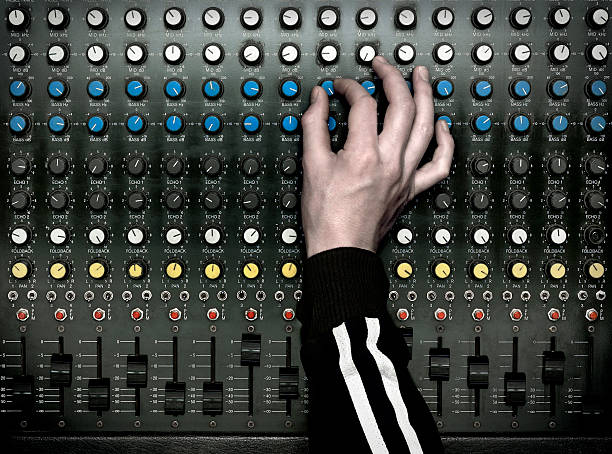You don’t need a huge studio in a building somewhere fancy. You can create incredible sounds from your own home, providing you have the space and the set-up.
Building a home sound design studio doesn’t have to break the bank. With thoughtful planning and smart choices, you can create an effective and efficient studio space without spending a fortune. There are so many ways you can do this. It really depends on what you’re looking for and how advanced your equipment needs to be.
1. Plan your space
Choose the right room
Select a quiet room in your home with minimal outside noise. A smaller room with fewer windows and doors is preferable, as it will be easier to soundproof. It doesn’t have to be a huge room, but pick one that you won’t mind losing, as you won’t be able to share it with other hobbies or activities. It will become solely a music room.
Optimise the layout
Plan the layout of your studio to maximize space and efficiency. Position your desk and equipment in a way that allows for comfortable workflow and easy access to everything you need. Try different layouts to see what’s easier. You might find having your computer in one area is more convenient to reach other equipment.
2. Essential equipment
Computer
A reliable computer is the heart of your sound design studio. You don’t need the latest model; a mid-range computer with good processing power and enough RAM (8GB or more) will suffice. Look for refurbished or gently used models to save money. If another musician upgrades, see if you can get a good deal on their old equipment. It will be looked after.
Digital Audio Workstation (DAW) software
Choose a DAW that fits your needs and budget. Free options like Audacity or GarageBand are great for beginners. For more advanced features, consider affordable options like Reaper, which offers a discounted licence for personal use. Try before you buy because some musicians get on with some platforms better than others.
Audio interface
An audio interface is essential for connecting your microphone and other audio equipment to your computer. Look for budget-friendly models from reputable brands like Focusrite Scarlett Solo or Behringer UMC22. You can upgrade further down the line, but to start with, pick something good but affordable because equipment can be expensive.
Studio monitors
Good studio monitors provide accurate sound reproduction. Look for entry-level options like the PreSonus Eris E3.5 or JBL Professional 305P MkII. Alternatively, quality headphones like the Audio-Technica ATH-M50x can be a cost-effective substitute. Again, ask around in the industry, someone might have some you can buy second-hand.
Microphone
A decent microphone is crucial for recording sound effects and voiceovers. The Audio-Technica AT2020 and the Samson Q2U are affordable options that offer excellent sound quality. Your microphone is worth investing in. Try to buy the best your budget can stretch to. Otherwise, you’ll need to replace it sooner than hoped.
3. Soundproofing and acoustics
DIY soundproofing
Soundproofing doesn’t have to be expensive. Use heavy curtains, rugs, and furniture to absorb sound. Place bookshelves against walls to help block noise. If you are finding noise creeps through, and you can’t turn it down, then invest in some foam soundproofing. You can buy it in a range of designs and it can look really funky.
Acoustic treatment
Improve your room’s acoustics with DIY solutions. Use foam panels, homemade bass traps, and acoustic blankets to reduce echo and improve sound quality. Egg cartons and thick blankets can also serve as makeshift acoustic treatment. You don’t want the sounds being recorded to sound echoey or grainy. Make sure the acoustics are right.
4. Additional accessories
Pop filter
A pop filter for your microphone can prevent plosive sounds from being recorded. You can buy one inexpensively or make one yourself using a wire coat hanger and tights. If you’re really on a budget, then there’s no need to buy everything when you could potentially create some items yourself.
Cables and stands
Ensure you have all necessary cables and stands for your equipment. Buy durable but budget-friendly options. Brands like AmazonBasics offer affordable cables and stands that are reliable. You can always replace these at lower costs. There’s no need to buy really expensive cables if you store them correctly. They should last a long time.
External hard drive
An external hard drive is essential for backing up your projects. Look for sales or refurbished models to find a good deal. Having more than one hard drive is a sensible idea. You never know when technology will fail. If you have your content backed up on multiple places, you’re covered if anything does go wrong.
5. Software and plugins
Free plugins
There are many free plugins available that can enhance your DAW. Websites like VST4Free and Plugin Boutique offer a variety of free tools for sound design. There’s no harm in trying them out. Why not try a few and see if any benefit you?
Affordable sound libraries
Building a sound library is crucial for sound design. Look for free or affordable sound libraries online. Websites like Freesound.org offer free sound effects, and sites like Boom Library and Sonniss have budget-friendly options.
6. Learning and improvement
Online tutorials
There are countless free tutorials available on YouTube and educational platforms like Coursera and Udemy. These can help you learn new techniques and get the most out of your equipment and software.
Practice regularly
Consistent practice is key to improving your skills. Work on small projects regularly to refine your techniques and develop your unique sound design style. Practise makes perfect. Once you have your sound room, you can get creating as much as you like.
Building a home sound design studio on a budget is entirely possible with careful planning and smart purchasing decisions. By prioritising essential equipment, using DIY solutions for soundproofing, and taking advantage of free and affordable resources, you can create a functional and inspiring workspace without spending a fortune. Start small, and invest wisely.







